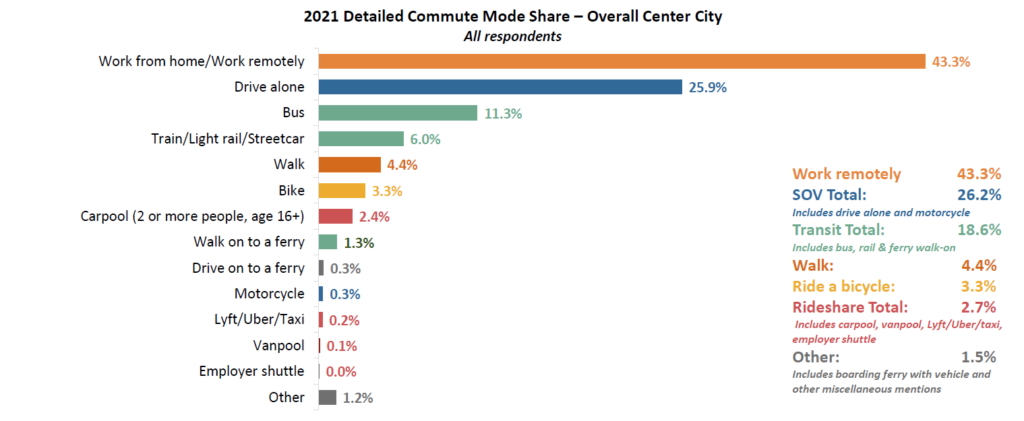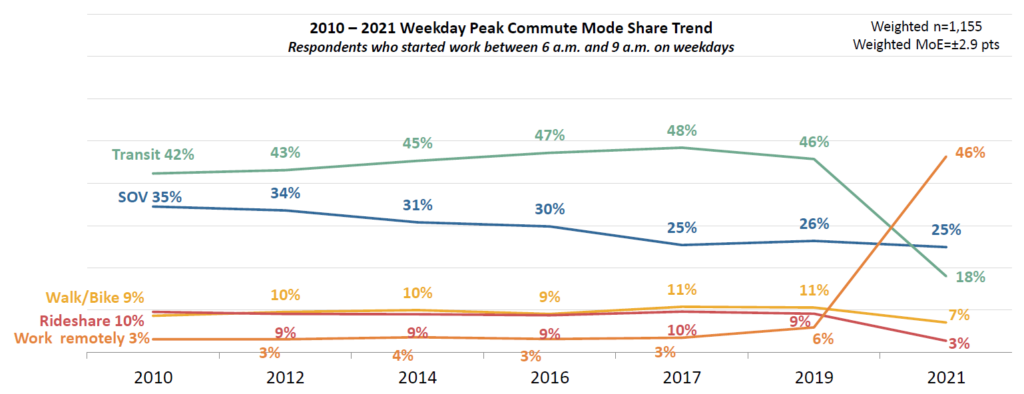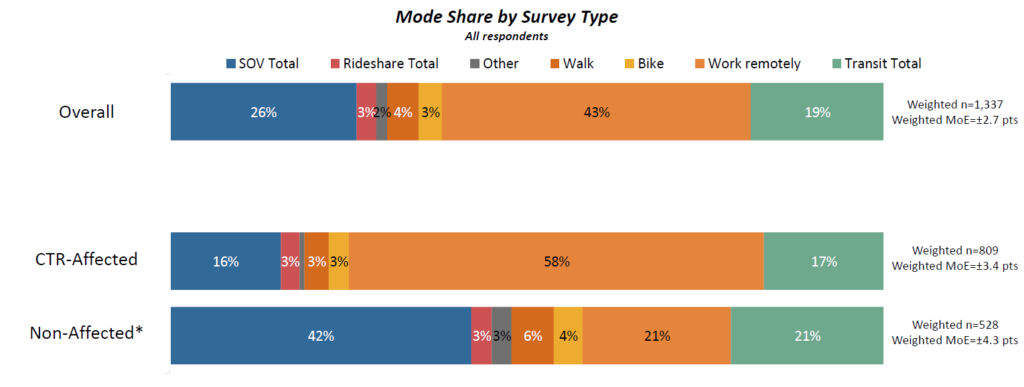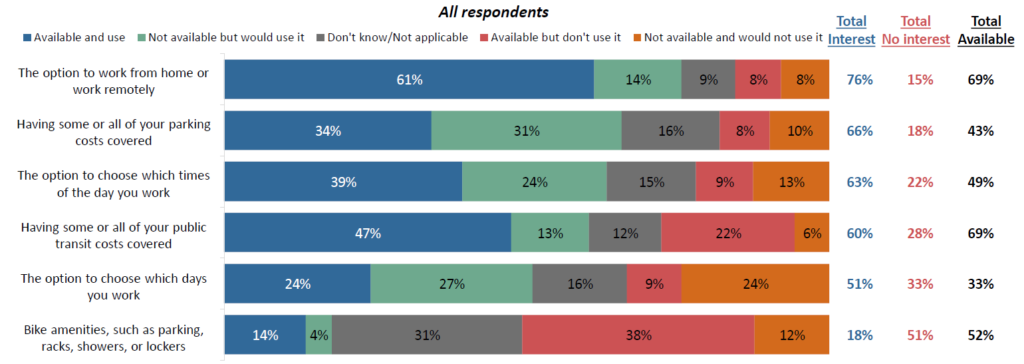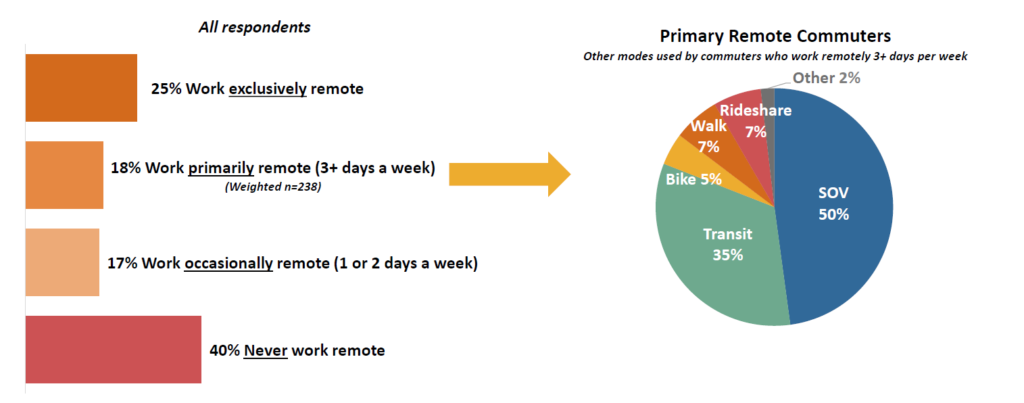Are you curious about what commuting downtown looked like during 2021, among the impacts of remote work and other pandemic effects? The 2021 Center City Mode Split survey offers great insights. This survey, first implemented in 2010, tracks trends and changes in travel behavior and attitudes of commuters to downtown Seattle over time. Commute Seattle and its partners at SDOT, DSA, Metro, and Sound Transit use the results to gain insight into the travel choices commuters are making, and better understand and plan for impacts on transportation infrastructure, climate, local economy, and even public health. The results have also been instrumental in demonstrating the success of the public and private sectors working together to make Seattle a champion of climate-friendly commuting.
For the 2021 Mode Split Survey, a total of 4,371 individuals were surveyed from 263 participating worksites. Data collection took place between October 18th and November 28th, 2021. The results highlight a few key themes:
- The COVID-19 pandemic has led to significant mode shifts among Downtown Seattle commuters, most importantly a sizeable increase in remote work and decrease in transit.
- Worksites affected by Washington State’s Commute Trip Reduction (CTR) law, with 100 or more full-time employees starting work between 6-9am, have generally seen fewer physical commute trips than before the pandemic and have been slower to bring employees back to their worksites.
- The availability of commuter benefits differs between employees at CTR affected and non-affected worksites, most notably around the availability of remote work options and transit.
Year-Over-Year Mode Shift
Prior to the onset of COVID-19, Seattle experienced a ten-year trend of reduced single-occupant vehicle (SOV) commute trips, and was one of the only cities in the United States with continuously increasing transit ridership year-over-year. Investments in expanded public transit options, protected bicycle infrastructure, and employees living near their workplaces helped more Seattleites opt for non-driving commutes.
However, the pandemic significantly altered travel behavior, and this year’s data broke from these historic trends. Comparing 2019 to 2021, the share of remote work among all Downtown commuter modes increased by 36 percentage points, to 43.3% of all surveyed trips. The percentage of transit trips, once at an eight-year high, dropped from nearly 50% to 18%. Walk/bike and rideshare trips decreased slightly, while the percentage of those driving alone to work remained flat.
Disparities in Mode Share and Benefit Availability
The pandemic has also sharpened the contrast in commute behavior between large employers, who are generally able to provide more flexibility around remote work as well as more generous commuter benefits, and small businesses, who often employ essential workers and may offer fewer commute perks. This year’s study showed that employees at large businesses (CTR affected) were more likely to be working remotely in November, while smaller employers were more likely to travel into the office and choose to drive as they did so.
In this year’s survey, we added a few new questions about transportation benefit availability and usage among survey respondents, and uncovered additional differences between large and small businesses. While 60% of employees at large companies reported having transit benefits available and using them regularly, only 29% of employees at small and medium-sized businesses reported the same. This highlights an unmet demand for employer-subsidized transit benefits among employees at smaller worksites in Seattle, with 21% of employees at businesses with under 100 employees reporting that they did not currently have a public transit benefit available, but that they would use one if their employer covered or subsidized the cost.
Among larger worksites, 74% of commuters reported having and using the option to work remotely at least part-time. However, at smaller worksites, that number was only 42%. 23% of employees at smaller worksites reported that they didn’t have the option to work remotely, but that they would do so if they could.
These disparities highlight an opportunity for more robust transportation demand management (TDM) programming focused on smaller worksites in Seattle. With affordable options like the ORCA Business Passport program, even small businesses can afford to support their employees in making climate-friendly commute choices. The City of Seattle’s Commuter Benefits Ordinance requires at a minimum that businesses with 20+ employees allow the use of pre-tax pay for transit, and outreach and support for that requirement is part of Commute Seattle’s work with small businesses . Commute Seattle can help – contact us today!
Remote Work and Secondary Commute Choices
Many more Seattleites are working remotely than ever before, with 25% of commuters working exclusively remotely, and another 1-in-5 doing so three or more days per week. That said, according to survey responses, remote workers might be more likely to drive alone on the days they do need to travel to work. Among primarily remote workers, half drive alone to work on the days they take physical trips, which far exceeds 2019’s 26% drive-alone rate. As more employers bring their workers back in-person at least part time in the coming months, it’s important to emphasize that commuters should not default to driving alone to the workplace. Traffic congestion in Seattle has nearly returned to pre-pandemic levels, and a continued increase of cars on the road will have a climate impact as well.
Attitudes Towards Transit Usage
Commute Seattle continues to emphasize the potential for employers to take advantage of the “fresh start effect” as they bring workers back to the office – when commuters are already experiencing one big life change (returning to in-person work), they may also be more open to trying other new behaviors, such as taking advantage of climate-friendly commute options.
Encouragingly, 67% of survey respondents reported that they plan to use public transit services more often once the COVID-19 pandemic is no longer a serious public threat. This provides an opportunity for employers to encourage transit trips, even for employees who are working remotely part-time, and to provide subsidized transportation benefits to further incentivize these behaviors. Reducing vehicle trips into downtown Seattle and throughout the region can not only help reduce congestion on our roadways, but also contributes to helping Seattle meet its climate goals and improve quality of life for employees.
Looking for More Data?
For questions, comments, or interview requests, please reach out to Madeline Feig at madelinef@commuteseattle.com.

